
An Oklahoma tornado courtesy of Shutterstock
Before moving to Georgia in my adolescence, I lived in Stillwater, Oklahoma for the first 12 years of my childhood. It was a wonderful place to grow up as a boy.
There were flat streets for my brother and I to skateboard all around town, lots of arcades for us and our friends to dump quarters into, and fishing at Theta Pond. Oh, and chili cheese dogs on Washington Street.
But there was also a harrowing threat of living in Oklahoma, especially in the summer. That’s because the state is home to more tornadoes than any other place in the world—right smack in the middle of Tornado Alley. And I distinctly remember many close encounters with them, if not once every other summer.
My first memory of a tornado was watching a slow and calming funnel cloud form directly over my house on Admiral Street. It was this giant, swirling, but graceful thing that looked like it could explode into a tornado at any moment. My family and I all watched from our front yard. No one said it, but I’m sure all of us we’re thinking: “Please don’t touch down. Please.” We didn’t run because it wasn’t violent looking, and the sirens hadn’t gone off yet. In other words, when you live in Oklahoma, you learn to live with the threat of tornadoes every summer. And you don’t scramble for cover or storm shelters until you can feel, observe, and hear that something violent is about to happen. Continue reading…

My friend’s daughter is an aspiring writer and recently interviewed me. This is what I told her:
1. Do you work for someone specifically or do you have an agent or have to find someone new to write for after you finish a project?
I own my own freelance writing business and spend around half my time asking people if I can write for them and the other half actually writing. I don’t have an agent.
2. What kind of writing is it?
Tech and travel writing for websites, newspapers, and Fortune 500 companies. I’ve also written a couple of books.
3. Do you enjoy it?
No. I LOVE it. Doesn’t feel like a job. More like a calling really. I have no plans of retiring and intend on writing until I die, I like it so much. 😃 Continue reading…

These were shared with me without an attributed author but are spot on:
- Time passes much more quickly than you realize.
- If you don’t take care of your body early then it won’t take care of you later. Your world becomes smaller each day as you lose mobility, continence and sight.
- Sex and beauty may fade, but intimacy and friendship only grow.
- People are far more important than any other thing in your life. No hobby, interest, book, work is going to be as important to you as the people you spend time with as you get older.
- Money talks. It says “Goodbye.” If you don’t plan your finances for later in life, you’ll wish you had.
- Any seeds you planted in the past, either good or bad, will begin to bear fruit and affect the quality of your life as you get older — for better or worse.
- Jealousy is a wasted emotion. People you hate are going to succeed. People you like are going to sometimes do better than you did. Kids are going to be smarter and quicker than you are. Accept it with grace.
- That big house you had to have becomes a bigger and bigger burden, even as the mortgage gets smaller. The cleaning, the maintenance, the stairs — all of it. Don’t let your possessions own you.
- You will badly regret the things you didn’t do far more than the things you did that were “wrong” — the girl you didn’t kiss, the trip you didn’t take, the project you kept putting off, the time you could have helped someone. If you get the chance — doit. You may never get the chance again.
- Every day you wake up is a victory. It’s never too late to become what you wanted to be or might have been if you start now.

Thanks for reading and sharing my latest clippings:
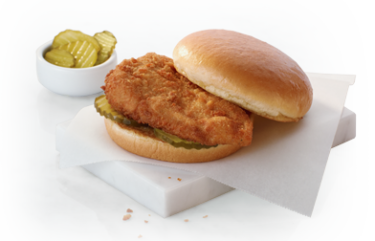
Chick-Fil-A
I want all my children to work fast food someday. Why would I subject the little darlings to low pay, hectic dinner rushes, rude customers, demeaning work, ignorant coworkers, monotonous tasks, slippery shoes, and stinky clothes?
The short answer: Life is filled with the above, so you might as well expose ’em while they’re young. The long answer: Much of what I learned in business I learned from fast food. Not the creative stuff. Not sustained rejection. Certainly not cerebral problem solving.
But working fast food taught me the essence of hard work—livelihood’s version of basic training. After two years as a low-level cooking, toilet cleaning, truck unloading, chicken suit wearing, stench absorbing, fry serving, drive-thru calling, and overly perspiring wage-worker at Chick-Fil-A, here’s what I learned about business, customer service, teamwork, and life: Continue reading…

Courtesy iStock
I love food. I love America. Put the two together, and you get these, the 12 most iconic American foods:
- Hamburger. Classic. Fantastic. Our biggest culinary export. The perfect example of our super-indulgent, informal, on-the-go style food.
- Tex-Mex. Mexican is the greatest Latin American cuisine and arguably better than even Spanish cuisine. But bastardized American-Mexican is just as good. Believe it or not, chimichangas, nachos, fajitas, burritos, hardshell tacos, and “American tacos” filled with seasoned ground beef, lettuce, tomato, sour cream, and cheddar cheese were all invented in America, not Mexico. They all rock.
- Pizza. Originally invented by Italy, but perfected in American with flimsy, foldable New York style, deep dish Chicago style, and rectangle, focaccia Detroit style. All three are delicious!
- Fried chicken. Roast chicken is one of the most savory things you will ever taste in your life. Fried chicken is like roast chicken on “carb-o-rated” steroids. So unhealthy but so, so good.
- Peanut butter and jelly. I freakin love these things and still try to eat one a month. I ate one nearly every weekday as a kid.
- Bar-b-que. Brisket. Pulled pork. Dry rub. Dripping wet. Vinegar based. Mustard based. It don’t matter. They’re all scrumptious.
- Chocolate chip cookies. Although not our most popular dessert (see below), it’s my personal favorite. Thank you, Toll House!
- Ice cream. Need I say more?
- Brownies. It is a cake or chocolate cookie? Both!
- Macaroni and cheese. Pasta cooked in milk and mixed with gooey cheddar cheese? Yes please!
- Hot dogs. Although a known carcinogen, these little sausage rockets topped with mustard, relish, and onions are worth eating every now and then.
- Popcorn. Is there a greater finger food? Probably not.
Honorable mentions: Thanksgiving dinner, pumpkin pie, cornbread, clam chowder, mashed potatoes, apple pie, biscuits and gravy, key lime pie, clam chowder, tater tots.

Courtesy Shutterstock
The phrase, “Golf can be learned in an afternoon,” has never been said. Not once. Ever. For most people, the game truly requires a lifetime to master.
There are some things you can do, however, to tip the scales in your favor when playing an opponent. Some of them are obvious—more helpful reminders than anything. But others less so. Either way, all will have a positive effect on the outcome of your next round.
So after years of research — and by that I really mean a single afternoon of thinking really hard about it — I give you the best eight ways of beating someone at golf: Continue reading…

Although Americans don’t think of them as such, peanuts are vegetables. And boy are they delicious! Grown underground as a legume and not actually a nut, this commonplace superfood is half fat, quarter, protein, and quarter sugar. They were first discovered over 7,000 years ago in Peru, before spreading to the rest of the world. In 1890, America invented peanut butter, which quickly became chocolate’s favorite condiment. In the 1950, America sent lots of peanut butter to combat famine in West Africa, and they used to to invent Peanut Soup with tomatoes that is absolutely fantastic. Peanuts can be dry roasted, boiled, blended into a butter, or my personal favorite, cooked in oil (aka cocktail peanuts). They are crunchy, nutty, slightly oily, and dare I say timeless. They get a bad wrap for being boring. But I eat them nearly everyday. Like potatoes, I admire them for their versatility. ★★★★★

Over the last 18 months, my family has doubled down on a mostly vegetarian, part-time vegan diet. We eat meat only once or twice a month, usually on holidays or special occasions. Same goes for desserts, usually on major holidays or birthdays.
Since my wife doesn’t like eggs, which is one of the best affordable superfoods, we eat a lot of oatmeal (boiled and baked), beans and rice, veggie pastas, lentils, peanuts, mixed nuts, hummus, big green salads, popcorn, oils instead butter, yogurt, macaroni and cheese, and plain ole carrots. We eat fruits in moderation, usually bananas, apples, and whatever’s in season.
Since becoming mostly vegan, I have never felt better. But I’ve also learned that eating healthy doesn’t have to be bland or expensive. In fact, I think we spend less on home cooked meals now than we did before, which really helps since the cost of food has skyrocketed over the last few years.
Either way, I love food more than ever and it feels great to feel better while still enjoying it.
See also: 26 secrets to eating healthy on a budget

Courtesy Shutterstock
“A student once asked anthropologist Margaret Mead, ‘What is the earliest sign of civilization?’ The student expected her to say a clay pot, a grinding stone, or maybe a weapon. Margaret Mead thought for a moment, then said, ‘A healed femur.’ A femur is the longest bone in the body, linking hip to knee. In societies without the benefits of modern medicine, it takes about six weeks of rest for a fractured femur to heal. A healed femur shows that someone cared for the injured person, did their hunting and gathering, stayed with them, and offered physical protection and human companionship until the injury could mend. Mead explained that where the law of the jungle and survival of the fittest rules, no healed femurs are found. The first sign of civilization, then, is compassion, as seen in a healed femur.”—Ira Byock, American physician
Asking the below is sure to elicit a much better response than inquiring about the weather.
 “What are you excited about?”
“What are you excited about?”- “What’s the best dining experience you’ve ever had?”
- “What’s been the best part of your week?”
- “What hobby have you always wanted to pick up?”
- “What’s the nicest thing anyone’s ever said about you?”
- “Do you have any good book, music, or movie recommendations?”
- “Would you rather be a time traveler or a mind reader?”
- “What’s the most interesting thing you’ve learned recently?”
- “How did you learn to be so good with your (talent)?”
- “If you could do anything without worrying about money, what would you do and why?”
- “What’s your perfect Saturday?”
- “How would your best friend introduce you?”

Courtesy Shutterstock
No one can predict the weather. But you can bend it to your will sometimes. Here’s how:
- Fly to a different climate. This is the most expensive option but arguably the most effective. Hop on a flight and enjoy a totally new season in mere hours.
- Go swimming. The most fun, if not affordable option. Only works in summer. Bonus points for making you feel like a kid again.
- Condition your air. Ya know—jack up the A/C, turn up the heat, start a fan, light a fire. Within a few minutes, you can reverse the outside weather.
- Head for cover. This is the fastest, might time-tested option. Could be an umbrella, under the shade of a tree, or cozy shelter. In life and in bad weather, there is no place like home.
- Change your attire. This may be the most overlooked, if not easiest option. In many cases, there’s no such thing as a weather problem, only an attire problem (i.e. you over or underdressed for the elements).
How you like them, life hacks?

Courtesy Shutterstock
More car crashes, wars (really!), bugs, asthma, wildfires, crime, marital strife, and sunburns. Other than that, it’s awesome! ☀️😎❤️

My Idaho-born father will cough in his ashes for saying this, but baked potatoes are boring. They need a lot of salt, toppings, or dressings to make them interesting. They have a hard time standing on their own. Although traditional, mashed potatoes are like baby food for grown ups. I’ll eat ’em, mind you. But I don’t think I’ve ever savored a bite of mash potatoes. In go the mashed starches! That said, potatoes take on a magical quality when thinly cut, battered, and fried. French fries, hash browns, even scalloped potatoes are pretty darn fun. And I’d be remiss not to mention funeral potatoes. But again those are mostly cheese, butter, onions, and cornflakes. The potatoes are just the vehicle to deliver those richer ingredients. If I sound a little harsh, it’s because I am. There are just so many more exciting vegetables in life. But what potatoes lack in flavor or texture, they more than make up for in versatility. ★★★★☆

With her high school diploma AND associate’s degree. She even won a big Taco Bell scholarship. I’m so proud of her.
Read more blogs about Sadie:

Thanks for reading and sharing my latest published work:
 If you’re able to organize your life without a calendar, I have two things to say: 1) You are a miracle; and 2) The following does not apply to you.
If you’re able to organize your life without a calendar, I have two things to say: 1) You are a miracle; and 2) The following does not apply to you.
For everyone else, I have some proven advice that will help you get the most from your daily, weekly, monthly, and even annual schedule, while helping you free up precious time and prioritize things that are more important to you.
In no particular order, they are as follows:
Continue reading…

Courtesy Shutterstock
In recent years, the queues to board commercial airplanes have gotten noticeably longer, chaotic, and sometimes testy. This is largely due to increasingly restrictive bag policies and sold out planes, which inadvertently encourage more passengers to board as early as possible to ensure their place on the plane.
Understandably, this causes a lot more gate stress for all involved, from economy passengers and gate agents, to first class fliers and anyone heading to a different gate. Is there a better way?
The answer is an enthusiastic “Yes!” according to the many self-proclaimed “Final Call” fliers I recently spoke to; the seemingly brave but still confirmed passengers who wait until “all rows have been called” and the lines have vanished before boarding. Better yet, all those I spoke to reported that neither their bags nor themselves had never been left behind, so long as they arrived at the gate at least 30 minutes early.
In other words, you don’t have to wait in line to confirm your place (or your bag’s place) on a plane. In fact, the pros of delayed boarding far outweigh the cons, according to those I spoke to. This is what you can expect while doing so. Continue reading…

Courtesy The Verge
“The reason websites continue to load, bank transfers go through, and civilization persists is because of the thousand or so people living aboard 20-some ships stationed around the world, who race to fix each subsea cable as soon as it breaks.” What a story!

For several months this winter and spring, my soon-to-graduate daughter submitted one scholarship application per day. Outside of some partial academic scholarships she won from accepted schools, she was rejected for each and every private scholarship she applied for.
Except one. The biggest one. The one she wanted most. The Live Mas Scholarship from Taco Bell, which she was awarded this month. Click on Utah to see her name. This was her touching and winning application that she wrote and edited all by herself.
I am so proud of her.

Courtesy Shutterstock
Wanna change the world? Here are 40 mostly easy things you can do everyday to make a difference while serving those around you:
- Smile and say hi to everyone
- Help your family by doing one of their chores
- Send an encouraging note
- Deliver treats to someone in need
- Look for someone alone and genuinely ask how they are doing
- Invite friends or family to dinner and ask how they’re doing
- Always hold the door open for strangers
- Give one sincere compliment each day
- Pay for the person behind you in a fast food line or a restaurant
- Text a family member to say I love you Continue reading…

I’ve lived long enough to see America champion or vilify certain foods every decade or so.
In the eighties, it was “low fat” everything and “SlimFast” meal replacement shakes, even though fats are one of three important macro nutrients our bodies need everyday, and chewing food is a lot more fun than drinking it.
In the nineties, “carbs are the enemy” was the new craze that continued into the early aughts, even though carbs (or sugars) are one of three important macros our bodies need everyday (and frankly about the only macro our high-energy brains can use).
In the aughts, “juice cleanses” and liquid diets were there surefire way to good health, even though our livers cleanse more in an hour than a lifetime of green smoothies.
Today, “high protein” diets and pseudo science “gut health” are all the rage, and yet America is as fat as ever, something calorically dense proteins and weird gut foods do not help us with.
The way we talk about food matters. While I believe there is such a thing as “good” and “bad” foods that can affect or long-term health, in the short-term, food is just food.
Moreover, as omnivores, our bodies need carbohydrates, fats, and protein to survive. Amazingly, our bodies will even convert its fat storages to whichever macro it needs most before sending it to our liver for rapid use.
Long story short—eat your macros, mostly plants, not too much, and have fun once in a while with the “bad” stuff.
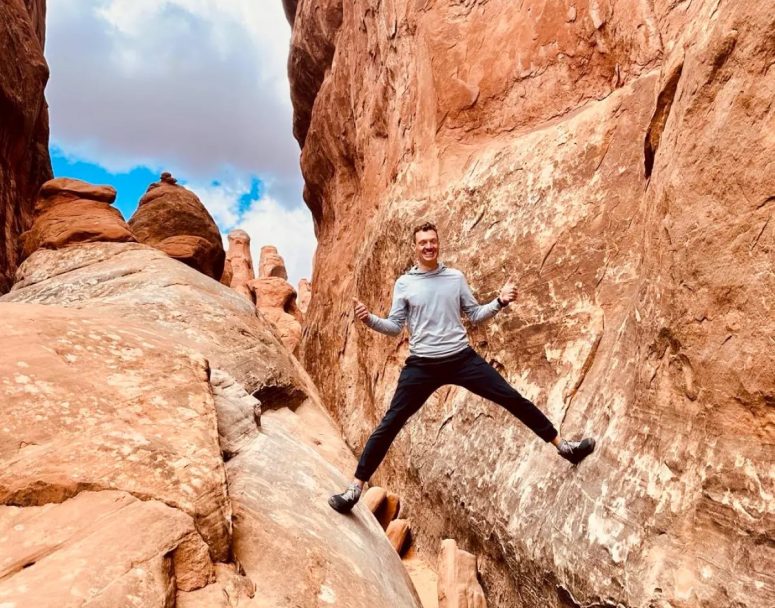
Thanks for reading and sharing my latest travel writing:

America has spoken. For the last 20 years, Reese’s has been the best-selling candy in the country by a wide margin. That’s because the classic combination of slightly flakey, if not overly sweet, peanut butter covered in fast-melting milk chocolate is nearly impossible to beat. Like Hershey Kisses, Reese’s have an interesting texture. Chocolaty ridge sidewalls first tickle the mouth in a rich and smooth way. Ince bitten, the sturdier peanut butter center presents an exciting contrast to the melt-in-your mouth (and often fingers) outer shell. Although admittedly mouth-watering, Reese’s are indulgently sweet. No salt or bitter notes here, which is disappointing. For a more irresistible, if not 5-star perfected, version of this classic combination, try Trader Joe’s mini dark peanut butter cups. Either way, tearing off the brown paper liners are a pretty fun act of anticipation. ★★★☆☆

My wife recently encouraged me to write a list of accomplishments to share with my kids. “Dad’s done some pretty cool things,” she told them. “He’s just super modest about a lot of them. 😊”
Modest or not, here goes! Continue reading…

Courtesy Shutterstock
This year democracy is facing extinction. America is at stake. If we elect the wrong president, the nation will likely die. Overnight. Call it, “Decision 2024: End of Democracy Edition.”
Sound familiar?
Every four years, Americans are patronized by fear-mongering media and desperate politicians with this blasé rhetoric. “This is the most important election ever,” they say. “Of our lifetimes! In the history of the universe!”
Ironically, the phrase has been slyly used since Lincoln’s second election in the late 1800s. It’s basically a hyperbolic trick to attract attention, sell more advertising, and mobilize voters. Continue reading…

Smithsonian
- We are the only animals with chins because it makes our faces look more attractive and symmetrical, which is important to facial recognition and social being.
- We are taller in the morning since our cartilage and discs are squished by gravity while standing upright through the day.
- Our jaw is our strongest muscle. Our eyes are the fastest muscle.
- Our intestines are always moving. The 20 foot long small intestine digests our food and absorbs all nutrients and most of our water. The five foot long large intestine absorbs vitamins and remaining water before pooping out waste.
- We convert any excess nutrients that our body doesn’t immediately need into fat within 4-8 hours of chewing. We can convert any nutrient, including protein and sugars or carbs, into fat for latter survival.
Continue reading…

This is Lucy. She was my family’s first real dog after Harley didn’t work out. She lived with us for 10 years and was an amazing pooch.
We put her down this spring after she bit and killed our neighbor’s cat, while walking with our son. Over the last year, Lucy became increasingly aggressive and loud as her hearing and eyesight worsened with age (a common trait among aging dogs and grandpas). Before that, she was remarkably chill and never bit or really barked at anything before.
It go so bad, however, that we recently had to limit her walks, and I stopped taking her on backpacking trips, since she became more of a nuisance on those trips compared to the fun she used to be for the first nine years of her life. This saddened me because I started to resent Lucy in her final year. I suspected we might have to put her down soon if her aggression and health worsened. But I never thought it would have ended like this.
It makes me sad just thinking about it. But here we are. Lucy’s gone. I miss her. And I regret not taking one final picture with her, walking with her in the mountains one last time, or giving her a big bowl of ice cream before euthanizing her.
I believe all dogs go to heaven, though. So if I get there too, I look forward to seeing Lucy’s docked, nubby tail wiggle with excitement again and doing all three of those things with her. Until then, here are some of my favorite captioned photos of this one-of-a-kind mutt (50% bulldog, 25% beagle, 25% labrador.)
So long Lucy. We love you. Continue reading…

Courtesy Blake Snow
Want to be a better traveler? Consider adopting these good habits before your next trip, and take your travel game to the next level. Continue reading…
The following is an excerpt from Log Off, available now on paperback, Kindle, and audiobook
 The “king complex.”
The “king complex.”
That’s the reason it’s difficult for many individuals to leave the internet—even for as little as a few hours in the evening, over a weekend, or on vacation. In short, the internet makes us feel like kings.
“Bring me this,” I demand, and it does. “More!” I say. It complies. “Still more!” It does not disappoint. “Let me watch, this, that, and the other.” Each time, I ask, it delivers, because it’s endless. When I run out of requests, I move to new subjects and interests.
In the event the internet is unable to supply what we ask of it—say, a physical experience, creation, or sensation—it will simulate that experience as often as we like from all possible angles: videos, photos, secondhand observations and reviews by those who have actually experienced what we’re after.
As you can see, the internet offers power, or at least the illusion of it. That’s the real reason the internet is so addicting. For the first time in human history, everyday people can convincingly simulate the experience of kings and exercise dominion over their own fantasized corner of reality. Continue reading…

Although they’re made with waxified commercial chocolate, Hershey Kisses are a textural phenomenon. The teardrop shape is simultaneously awkward and interesting. Perfectly portioned, Kisses sorta stab the roof of your mouth, then induce what feels like two teaspoons of saliva when the broad base chocolate hits your tongue. Often times I’ll crush the pointed tip with a molar, which is always satisfying. Either way, Kisses might be the funnest chocolate you’ll ever put in your mouth. Not the greatest tasting chocolate. But the shape-associated texture is what makes Kisses one of the best-selling and enduring American candies of all time. To top it off, the tiny tin foil and fortune cookie like paper label offer the fingers a delightful fidget opportunity while your mouth enjoys the contents. ★★★★☆

Ten years ago, I self-enrolled in anger management class. Next to marriage counseling, it was a turning point for my emotional intelligence.
Two year ago, I had the idea to quit swearing for good. I was convinced it let the cat out of the bag with my temper and I was right. I only swore eight times in 2022. And I only swore three times last year.
I say this because my number of outbursts and tantrums have dramatically dropped. It’s empowering. So if you have anger issues, I encourage to stop cursing because words matter.
Good luck!

Courtesy Wikimedia Commons

National Portrait Gallery
That’s the best justification for world peace, economic growth, and democratic propagation I’ve ever read.
It was uttered by President Clinton during his State of the Union address in 1994. He added that democracies “make better trading partners,” which is something the world has readily witnessed ever since.
Over the last 30 years, for example, the global poverty rate has nose dived from a staggering 70% then to 46% today. That rate is still trending downwards, as an increasing number of nations copy and paste the U.S. constitution towards sustainable democracies.
Not only does democracy reduce war and conflict, it actually enriches people. Which is why U.S. Foreign Policy is such a big deal, albeit one I don’t always agree with. But I realize it’s a whole lot cheaper and humane than war or imperial occupation.
So long as democracy doesn’t fight civil wars on others’ behalf (i.e. Vietnam, the Middle East), I wholeheartedly support more democracy and all that comes with it—the sometimes controversial first amendment very much included.
My name is Blake Snow, and I approve this message.

Photo courtesy Lindsey Snow
I recently returned from a two week expedition to Antarctica. After 10 years of travel writing, it is the greatest adventure I’ve ever been on, and my new favorite continent in terms of thought-provoking raw beauty. In fact, Antarctica gave me more pause and aroused more thoughts and feelings than any other place I’ve visited.
What did I learn while there? Here our five lessons I brought home. Continue reading…

While recording my debut album, I permanently damaged my inner ears. That’s because I listened to my headphones at volume 8-9 for four straight months. Every day. My ears have been ringing ever since.
Near the end of the recording process, the high pitched “tinging” started. I had also started playing in a live band then but wore ear plugs without realizing that I was letting the problem in the backdoor at the same time.
I read up on the ringing, and after speaking with two permanent “patients,” it was obvious I was suffering from either temporary or permanent tinnitus (pronounced tin-uh-tis). Time was the only way to tell which version I had. All the medical literature says if the ringing stops after 2-4 weeks, the ear cells were able to heal themselves and you’re good to go. If they don’t, the ringing will never go away, according to the latest research. Mine never did.
Obviously, permanent tinnitus, especially in both ears, is an incessant annoyance. But I’ve adapted well. And I’m grateful my ears alerted me to the issue before I was made deaf by music, as the tragic but still hopeful Sound of Metal movie so beautiful demonstrates.
What’s more, I haven’t suffered any noticeable hearing loss beyond maybe 5-10% clarity. I can still hear the soft breathing of my wife lying in bed next to me or even distant sounds. Although the ringing hasn’t gone away, my hearing remains largely intact.
There’s a very specific reason for that. The ringing is by design! The way it was explained to me, ringing ears are like the hissing you hear when turning speakers up real loud or on a radio while changing the station in search of something new. Similarly, ear cells change their frequencies, if you will, to make up for the loss of damaged cells. The living cells actually re-tune themselves (or ring) in an effort to listen more acutely with the remaining cells at their disposal. Magic I tell ya!
While I wish I never harmed my ears like I did, I often feel gratitude whenever I notice the ringing. It’s proof that my body and maker (be that God or evolutionary biology) care for me more than I care for myself sometimes. Isn’t that comforting?
TL;DR: Don’t blow out your ears, wear protection, and be grateful for how the human body adapts to survive.

Smart people don’t make better decisions because they’re necessarily more intelligent. They make smarter decisions, research shows, because they habitually do the following: Continue reading…

In Provo Music Magazine. And that’s pretty cool!
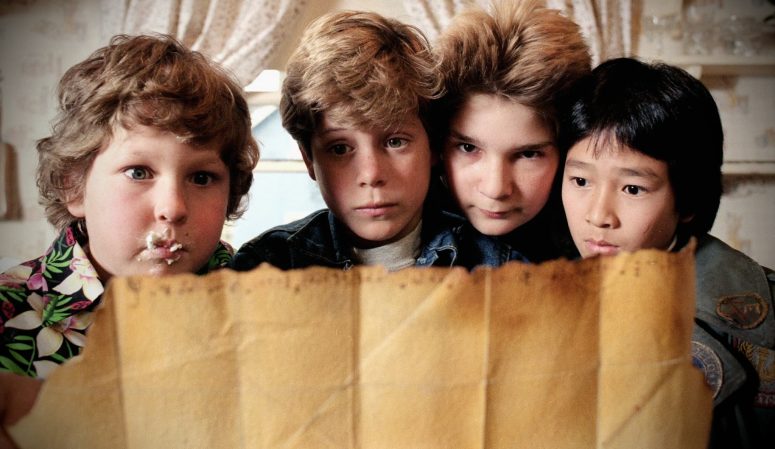
Courtesy Warner Bros.
My childhood was defined by ‘80s movies, music, fashion, and malls. It was a fantastically colorful, loud, fun and progressive decade to live through (although not as good as we have it today).
Although every decade has its share of hit films, the ‘80s are especially known for their irreverent, imaginative, and spectacular movies. Heck, they even invented “the blockbuster.”
If I could only watch 20 movies from the ‘80s, what would they be? In my opinion, you won’t find anything more iconic, classic, and radical than these: Continue reading…

I was recently asked if I write for myself or for others.
“Easy,” I exclaimed. “I write for myself.”
After 20 years of full-time writing, it means the world that my sentences, articles, and books have reached millions of people. Affirmation is my biggest love language.
But I never write for a single soul other than myself. I do this for two reasons. Continue reading…

Courtesy Shutterstock
Want to take a good photo? Follow the rule of thirds. Want to live life to the fullest? Do the same.
In fact, I’ll make it even easier on you. Instead of dividing your life into three vertical columns and three horizontal columns, simply divide it into three overall columns for maximum balance. They are as follows: Continue reading…

Courtesy Shutterstock
Every human needs a little help sometimes. Here are seven, science-backed ways to improve your mental health this year:
- Reconsider your social media use. While I’d encourage you to cancel social media altogether (the last 15 years have been amazing!), I realize this is a huge ask. But in the very least, you should restrict your social media use for maximum fulfillment, as I wrote in my best-selling book Log Off.
- Reconnect with a long lost friend. Simply text or say the following: “I thought of you today and miss you. How are you?”
- Empathize with someone different from you. People with high levels of empathy tend to function better in society than those with low levels. So go out of your way to meet, learn from, and befriend people that don’t look, think, or talk like you.
- Stop ruminating about work. It can wait until tomorrow morning or after the weekend. One of the best way to overcome this is to simply write down what you need to do and schedule time on your calendar to take care of it later.
- Make time for fun, mastery, social, and physical activities. You should be doing at least one of each every weekday, including fun things that excite you, cleaning or errands that make you feel good, excercize, and talking with your favorite people. If you’re the type that’s always helping others, carve out 20-30 minutes of “me time” everyday to reduce stress.
- Write a thank you letter. Gratitude increases happiness better than just about anything.
- Consider therapy if your emotions need some help. I’ve done this twice before and it saved my marriage and tempered my anger management. A good friend of mine is also visiting a therapist for the first time this year and loving it. I’m so fond of counseling that I’m gifting it to all of my kids and their spouses when they get married.

Courtesy Whitelines Snowboarding
I can tell you the exact moment snowboarding became cool. It was in 1985 when James Bond fastened helicopter shrapnel to his feet and rode down a mountain on a makeshift snowboard while a bunch of goons on skis struggled to keep up.
I can also tell you the exact moment it became uncool—at least in my world. While discussing the upcoming winter season recently with two millennials, I doubted my age after both of them grew up skiing since, “snowboarding is what my old man does.”
“If I still snowboard, does that make me an old man?” I asked myself. Continue reading…
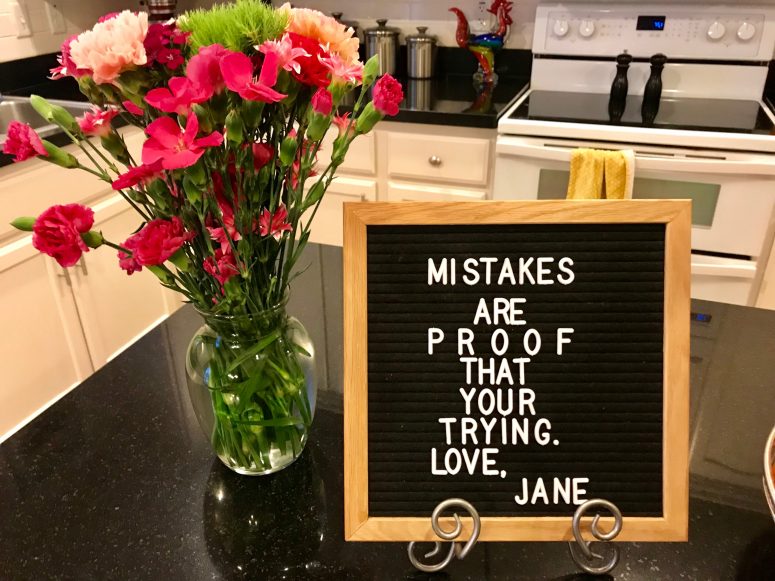
I made a boo-boo at work yesterday. The client I was working with was very understanding, forgiving, and even accepted some of the blame. But I felt pretty rotten about the oversight.
Now, I’m not a perfectionist because done is better than perfect. But I couldn’t shake my disappointment of letting them down. So much so that I continued to worry about my mistake into the night.
Then I awoke to the above new sign on display in our kitchen today, which was ironically crafted by my eight year old daughter. It immediately cheered me up. Partly because I learned some things from my mistake and instituted two immediate changes that will make me a better writer. But also because the sign reminded me that it’s okay to make mistakes.
Showing up really is half the battle. As my friend David says, “You gotta play some sour notes in order to make your sound sweeter.” I’m grateful of those simple truths that make improvement possible.
Thanks, Jane.
This story first published to blakesnow.com in 2018

Hope you enjoy my first story for the Washington Post: “That’s all you packed?” my fellow hiker asked, looking at me in disbelief.
“We were just about to start a four-day, 50-mile hike along the Jordan Trail into Petra. And I had carried only a single fanny pack across the Atlantic Ocean for my first week in the Middle East.
“At 10 liters, my Bergans “hip” or “waist” pack is the biggest money can buy. But it’s still only half the size of a small backpack. How is it possible to travel so far with so few possessions? And why on Earth would anyone do that?”
Continue reading…

Courtesy Celebrity Cruises
FORT LAUDERDALE—Celebrity Cruises look different, taste different, sail different, and value things that other cruises lack, like “all included” packages, plus ship layouts and guest rooms that feel more like a spacious resort than cramped passenger ship.
They are not the funnest ships on the high seas—nor the biggest or family-friendliest. But they are the most relaxing, delicious, and healthy ships sailing today. And thanks to incentivized fares that are only slightly higher than its competitors, Celebrity is also a “best buy” in cruising, despite their premium digs.
The recently launched Celebrity Ascent is the embodiment of this approach. Built for nearly a billion dollars, the 1,000 foot, 3200 passenger vessel doubles down on what its three older “Edge Series” siblings do so well. It’s 20% more fuel efficient, which is good for the planet. And it serves a greater variety of global cuisines, fanciful restaurants, and fresh produce than others, which is good for the belly.
On the inaugural christening last month, my daughter and I boarded the Ascent in less than five minutes, while armed with Celebrity’s snazzy app. We then devoured two charcuterie plates, a wholesome salad, and washed it all down with a pretentious Pellegrino from the Ocean View buffet, which seriously gives Vegas buffets a run for their money. Not exactly. But close.
Continue reading…

Here are my latest columns for Paste Magazine. Thanks for reading and sharing the ones you enjoy:
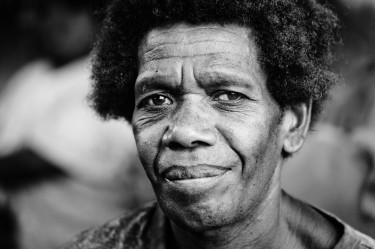
Wikimedia Commons
One of my goals in life is to become a centenarian, someone over 100 years of age. A few years ago, a team of researchers identified four areas that had the highest number of centenarians per capita in the world. They studied these people, wrote a book about them, then distilled their similar lifestyles down to a set of consistent life-giving habits.
And by life giving, I really mean death halting. Since there’s no brake on death, the best you can do is ease off the accelerator. With my added commentary, here are eight ways to do just that, as compiled by author Dan Buettner:
- Find a physical activity you enjoy and keep doing it. Do it for as long as you enjoy it. If and when you tire of that activity, find something else that pleases you. For example, you could start jogging, and if that becomes a bore, move to biking. Then swimming. Then Pilates. Then kickboxing. Then underwater basket weaving. Whatever it is, be sure to do it at least three times a week, moreso for idle or cubicle people. (In my case, since I sit at a desk and work from home, I have to move a lot more than most people to achieve the optimal amount of fitness.)
- Stop eating when you’re no longer hungry, as opposed to being full. There’s a difference. About 20% less food per meal, in fact. In short, this is the best known way to eat less. Stop when satisfied instead of stuffing yourself. Continue reading…
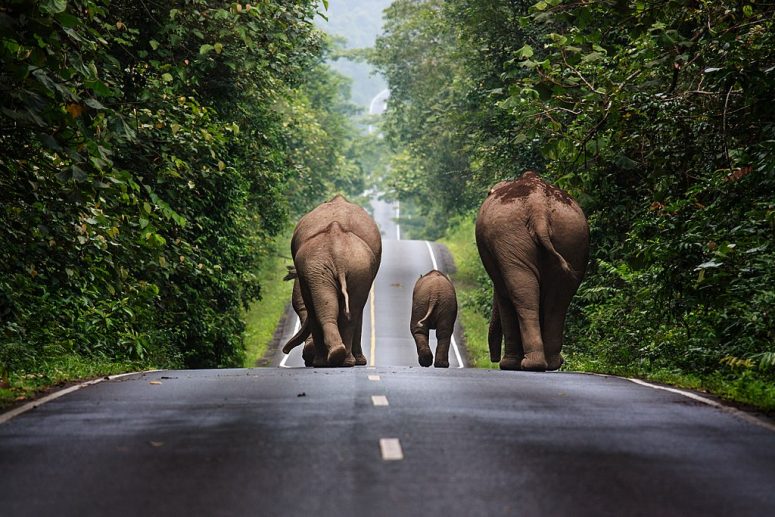
Wild elephants walking a road in Thailand’s Khao Yai National Park (Khunkay/Wikimedia)
(ENTREPRENEUR)—Is it easier for extroverts to travel than it is for introverts? Can travel be learned? If so, what does it take to overcome the fear, anxiety, and logistical challenges often associated with long-distance travel?
In search of answers, I asked several seasoned tourists and travel converts for their stories and advice. This is what I found.
First, the apple doesn’t fall far from the tree. People that travel as children are far more likely to travel as a adults. “Thanks to my parents, I started traveling when I was young,” says Avery Blank, an avid international traveler and strategy consultant from Philadelphia. “That made it relatively easy for me now to adapt to new cultures, surroundings, ways of doing things.”
Obviously if you were raised by homebodies, you’re at an immediate disadvantage. But so are risk-averse individuals who are particularly scared of the unknown, of which there are substantial amounts of when traveling to a new place with new customs and sometimes new languages.
“Much of the anxiety arising from travel revolves around being infantilized,” says Sheridan Becker, an American art director living in Belgium. “For example, not knowing how to do anything in a foreign language, asking for a bathroom, what to do if you lose your wallet, where your next meal will come from (and will you be able to stomach it), or how to handle medical emergencies.”
These are all disorienting questions, the fear of which keeps many people away. So extroverts don’t necessarily have an easier time traveling than less outgoing individuals. Rather, it’s more about how you were raised coupled with a willingness to try unexpected things that determine your propensity for travel.
The good news is wanderlust can be learned. Here are six ways to do just that. Continue reading…

Merry Christmas and Happy New Year!











 “What are you excited about?”
“What are you excited about?”




 If you’re able to organize your life without a calendar, I have two things to say: 1) You are a miracle; and 2) The following does not apply to you.
If you’re able to organize your life without a calendar, I have two things to say: 1) You are a miracle; and 2) The following does not apply to you.











 The “king complex.”
The “king complex.”

















